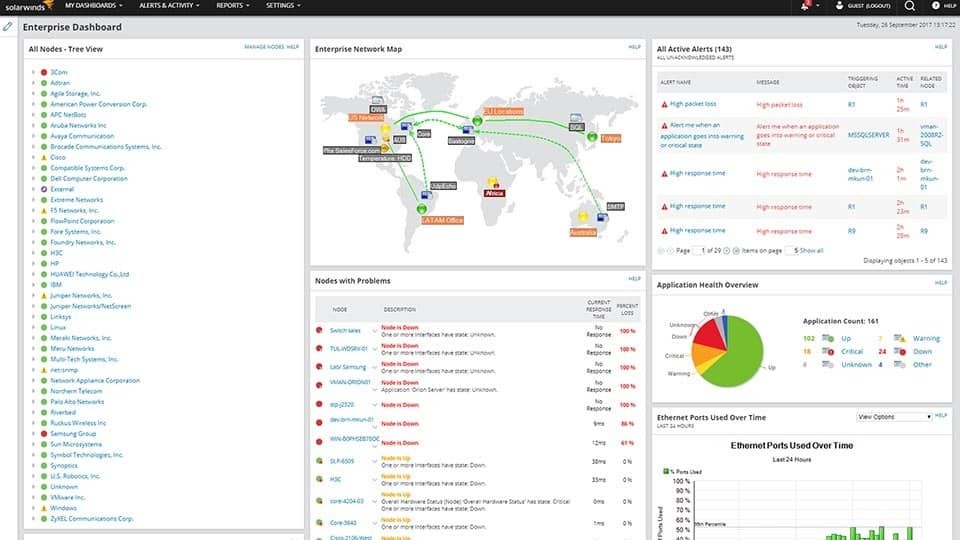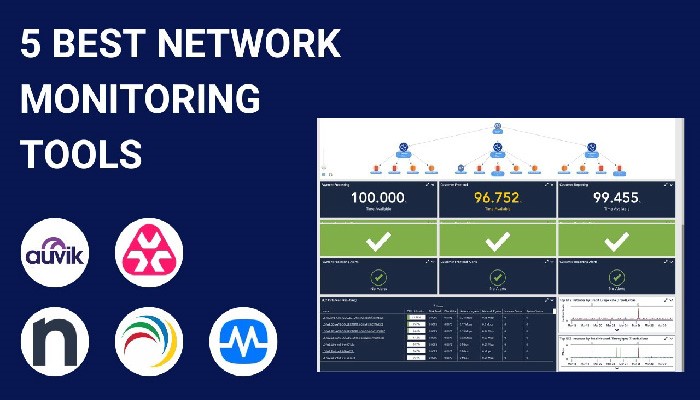Harnessing the Power of Network Monitoring Tools
In the fast-paced digital landscape of today, keeping a watchful eye on your network is not just prudent; it’s paramount. Welcome to the world of Network Vigilance – where proactive monitoring reigns supreme in safeguarding the heartbeat of your operations. Join us as we delve into the realm of Network Monitoring Tools and discover how they can elevate your business to new heights of efficiency and security. Let’s unlock the power of vigilance together!

What is Network Vigilance?
Network Vigilance is the unwavering commitment to monitoring and safeguarding your network infrastructure in real-time. It involves staying alert to any anomalies, potential threats, or performance issues that could impact the seamless operation of your systems. Think of it as having a virtual security guard watching over every digital interaction within your organization.
By embracing Network Vigilance, businesses can proactively identify and address issues before they escalate into major disruptions. This proactive approach not only enhances network reliability but also bolsters data protection measures against cyber threats lurking in the digital shadows.
In essence, Network Vigilance empowers organizations to stay one step ahead in an ever-evolving technological landscape where constant surveillance is key to maintaining operational excellence.
The Importance of Network Monitoring
Network monitoring is the backbone of any IT infrastructure, ensuring that networks function seamlessly. It plays a crucial role in detecting and resolving issues before they escalate into major problems. By continuously analyzing network performance, organizations can prevent downtime and maintain optimal operation.
Without effective network monitoring, businesses are at risk of facing costly outages that can impact productivity and customer satisfaction. Monitoring tools provide real-time insights into network traffic, bandwidth usage, and security threats, allowing for proactive management and quick responses to potential issues.
In today’s digital age where connectivity is key, having a robust network monitoring system in place is non-negotiable. It enables IT teams to identify bottlenecks, optimize resource allocation, and improve overall network efficiency. Investing in comprehensive network monitoring tools is essential for maintaining a competitive edge in the market.
Types of Network Monitoring Tools
When it comes to monitoring your network, having the right tools is essential. There are various types of network monitoring tools available in the market to suit different needs and preferences.
One common type is packet sniffers, which capture data packets traveling across a network for analysis. This helps in identifying any abnormal traffic patterns or potential security threats.
Another type is bandwidth monitors that track the utilization of network resources, allowing businesses to optimize their bandwidth usage and avoid congestion issues.
Network performance monitors focus on assessing the overall health and performance of a network by measuring metrics like latency, uptime, and throughput.
Security information and event management (SIEM) tools help in collecting and analyzing security data from various sources to detect and respond to cyber security incidents effectively.
Choosing the right mix of these tools based on your business requirements can significantly enhance your network vigilance capabilities.
Features to Look for in a Network Monitoring Tool
When it comes to selecting a network monitoring tool for your business, there are key features you should keep in mind. Scalability is crucial; ensure the tool can grow with your network. Look for real-time monitoring capabilities that provide instant insights into your network health.
An intuitive user interface makes navigation and data interpretation easier for IT teams. Customizable alerts allow you to set thresholds based on your specific requirements to receive notifications promptly. Compatibility with various devices and operating systems ensures comprehensive coverage of your network infrastructure.
Advanced analytics and reporting functionalities help in identifying trends and potential issues proactively. Integration capabilities with other tools streamline workflows and enhance overall efficiency. Prioritize security features like encryption protocols and access control mechanisms to safeguard sensitive data within the tool.
By considering these essential features when evaluating network monitoring tools, you can make an informed decision that aligns with your business needs seamlessly.
How to Implement a Network Monitoring System
Implementing a network monitoring system is crucial for businesses to ensure their network’s security and performance. The first step is to evaluate the specific needs of your organization. Identify what aspects of your network you want to monitor, such as bandwidth usage, traffic patterns, or device health.
Next, research and select a network monitoring tool that aligns with your requirements and budget. Consider factors like scalability, ease of use, and compatibility with your existing infrastructure. Once you have chosen a tool, it’s time to set it up by installing the software on designated servers or devices.
Configure the tool to collect relevant data and set up alerts for any anomalies or suspicious activities. Train your IT team on how to interpret the monitoring results and respond promptly to any issues detected by the system. Regularly review and update your network monitoring system to adapt to evolving threats and technology changes.
By following these steps diligently, you can establish an effective network monitoring system that helps safeguard your business operations from potential disruptions or security breaches.
Benefits of Network Vigilance for Businesses
In today’s digital age, businesses rely heavily on their networks to operate efficiently. Network vigilance plays a crucial role in ensuring the smooth functioning of these networks. By implementing robust network monitoring tools, businesses can proactively detect issues before they escalate, minimizing downtime and potential losses.
One key benefit of network vigilance for businesses is improved performance. Monitoring tools provide real-time insights into network traffic, bandwidth utilization, and device health, allowing IT teams to optimize performance and enhance user experience. This leads to increased productivity across the organization.
Moreover, network vigilance enhances security by identifying suspicious activities or potential threats promptly. With continuous monitoring and alerts for unusual behavior, businesses can strengthen their cyber security posture and prevent data breaches.
Investing in network vigilance not only boosts operational efficiency but also helps businesses stay ahead of evolving technology challenges in a competitive landscape.
Common Challenges and How to Overcome Them
Facing challenges in network monitoring is inevitable for businesses. One common issue is the overwhelming amount of data that can be difficult to analyze efficiently. To overcome this, businesses can utilize tools with advanced analytics capabilities to sift through data effectively and identify critical issues.
Another challenge is the lack of real-time alerts, which can lead to delayed responses to network issues. Implementing automated alert systems ensures that IT teams are promptly notified of any anomalies or potential threats, allowing for immediate action to be taken.
Moreover, scalability can pose a problem as networks expand and evolve over time. Choosing a flexible monitoring tool that can adapt to changing network requirements is vital in ensuring continuous visibility and control.
Security concerns also present challenges, especially with the rise of cyber threats. Employing robust security features within network monitoring tools helps safeguard sensitive data and mitigate risks effectively.
Future Trends in Network Vigilance
As technology continues to evolve at a rapid pace, the future of network vigilance is poised for exciting advancements. One trend that is gaining traction is the integration of artificial intelligence and machine learning algorithms into network monitoring tools. These technologies can analyze vast amounts of data in real-time, allowing for proactive identification of potential issues before they escalate.
Another emerging trend in network vigilance is the rise of cloud-based monitoring solutions. By leveraging cloud infrastructure, businesses can access their monitoring tools from anywhere, enabling greater flexibility and scalability. Additionally, cloud-based solutions often come with automatic updates and maintenance, ensuring optimal performance without extra effort.
With the increasing complexity of networks due to IoT devices and remote work environments, there is a growing focus on enhancing cyber security measures within network monitoring tools. Future innovations may include advanced threat detection mechanisms and enhanced encryption protocols to safeguard sensitive data.
The future trends in network vigilance point towards more sophisticated technologies aimed at delivering faster response times, improved security posture, and streamlined operations for businesses across industries.
Conclusion
In today’s fast-paced digital landscape, network vigilance is no longer a choice but a necessity for businesses of all sizes. Implementing robust network monitoring tools can provide real-time insights into your network performance, security vulnerabilities, and potential downtime risks.
By harnessing the power of network monitoring tools, organizations can proactively address issues before they escalate, optimize their network infrastructure for better performance, and enhance overall cyber security posture. The ability to monitor networks continuously ensures operational efficiency and business continuity in an increasingly interconnected world.
As technology continues to evolve rapidly, staying ahead of the curve with advanced network monitoring solutions will be critical for maintaining a competitive edge. Embracing future trends such as AI-driven analytics, IoT integration, and cloud-based monitoring will further streamline operations and drive innovation across industries.
Investing in comprehensive network vigilance through reliable monitoring tools is not just a best practice – it’s a strategic imperative for success in the digital age. Stay vigilant, stay proactive, and empower your business with the right tools to navigate the complexities of modern networking environments effectively.



